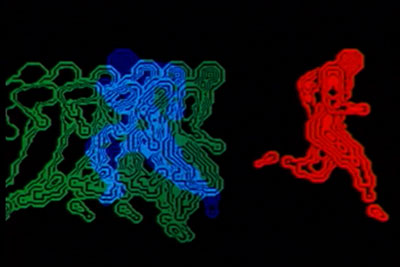kerjos-LookingOutwards02
“Olympiad” is a Lillian Schwartz piece from 1971, but it’s got its roots in a body of work nearly a century older: Muybridge’s naked athletes.


What you’re seeing on the screen is a body based on the Muybridge stills but rendered with “’a series of connected and overlapping octagons [1], ’” with hexagons in hexagons to show musculature, an ordered approach if we’re looking at them in terms of Galanter’s Generative Art Theory; each figure’s distribution of hexagons is similar to the next one’s.

The balance between order and disorder, I think, lies in the organic basis for the drawings: These predictable geometries are manipulated to the complex, adaptive movement of human muscles.
The animation itself takes advantage, with great exaggeration, of the Phi Phenomenon, which you can read about here, just as film and animation are already said to do. Schwartz, who lost much of her depth perception to scarring on her retina [3], has pursued a resulting interest in optical illusions in her work.
Click here to read more!
- 2. & 3. Nappi, Maureen. “Lillian F. Schwartz Redux: In Movement, Color and 3D Chromostereoscopy.” Leonardo, vol. 48, no. 1, Feb. 2015, pp. 55–59., doi:10.1162/leon_a_00894.